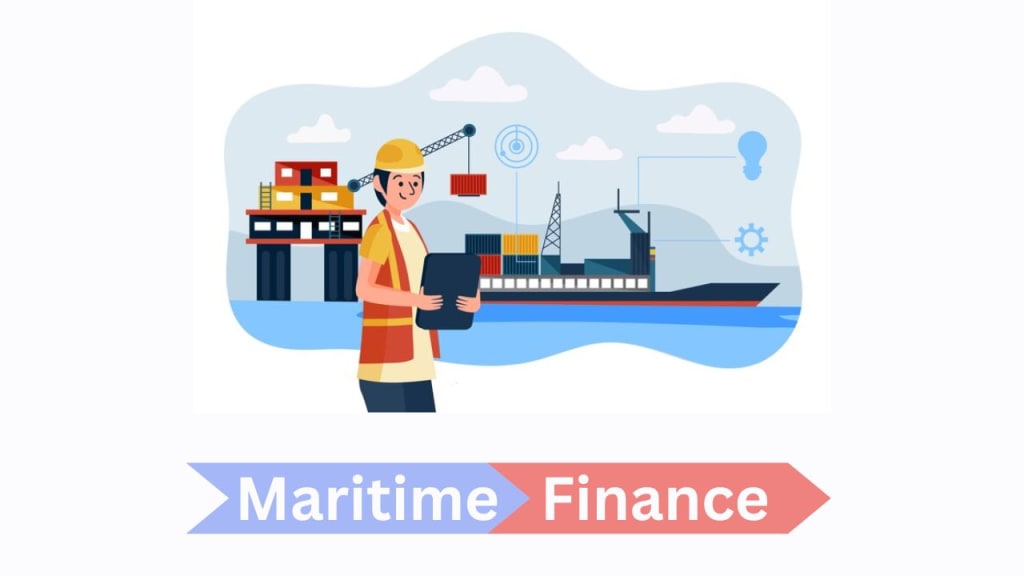Maritime finance refers to the financial services, instruments, and institutions involved in funding the maritime industry, which encompasses shipping, shipbuilding, port infrastructure, and related logistics. This sector plays a critical role in global trade, as it facilitates the transportation of goods and commodities across international waters. Given the significant capital requirements and the risks associated with maritime operations, specialized financing solutions have evolved to support this industry.

Key Components of Maritime Finance
-
Shipping Finance:
-
Vessel Acquisition: Financing the purchase of new or second-hand ships is a major aspect of maritime finance. This can be achieved through loans, leasing arrangements, or equity investments. Lenders often require collateral in the form of the vessel itself and may impose stringent conditions to mitigate risks.
-
Shipyard Financing: Shipyards, where vessels are built and repaired, require substantial funding for operations, modernization, and expansion. Financing options include bank loans, government subsidies, and private investments.
-
-
Operational Financing:
-
Working Capital: Shipping companies need working capital to cover day-to-day operations, including crew wages, fuel costs, maintenance, and port fees. This type of financing is typically short-term and may come from bank overdrafts, trade credit, or factoring.
-
Chartering: Shipowners may charter their vessels to operators on a time or voyage basis. The charterer pays a fixed rate, providing predictable cash flows for the shipowner. This arrangement can be backed by financing to ensure vessel availability and operational efficiency.
-
-
Infrastructure Financing:
-
Port Development: Ports are essential nodes in the maritime supply chain, requiring significant investments in infrastructure, equipment, and technology. Financing for port development projects can come from public-private partnerships (PPPs), government grants, and private equity.
-
Logistics and Warehousing: Efficient logistics and warehousing solutions are crucial for seamless cargo handling and distribution. Financing options for these projects include commercial loans, bonds, and venture capital.
-
Financing Instruments and Institutions
-
Traditional Bank Loans:
-
Banks have historically been the primary source of maritime finance, offering various loan products tailored to the industry's needs. These loans can be secured or unsecured, with terms and interest rates depending on the borrower's creditworthiness and the collateral provided.
-
-
Syndicated Loans:
-
Due to the high capital requirements of maritime projects, banks often collaborate to form syndicates, sharing the risk and providing larger loan amounts. Syndicated loans involve multiple lenders and a lead bank that coordinates the lending process.
-
-
Export Credit Agencies (ECAs):
-
ECAs are government-backed institutions that provide financial support to domestic companies involved in international trade. They offer loans, guarantees, and insurance to mitigate risks and encourage exports. In the maritime sector, ECAs play a crucial role in financing shipbuilding and export-related activities.
-
-
Private Equity and Venture Capital:
-
Private equity firms and venture capitalists invest in maritime companies and projects, seeking high returns on their investments. These investors often bring not only capital but also industry expertise and strategic guidance.
-
-
Capital Markets:
-
Maritime companies can raise funds by issuing bonds or equity in the capital markets. Bonds provide long-term financing with fixed interest payments, while equity offerings allow companies to raise capital by selling shares to investors. Publicly traded maritime companies can also benefit from increased visibility and access to a broader investor base.
-
Risk Management in Maritime Finance
The maritime industry faces various risks, including market volatility, regulatory changes, environmental concerns, and operational hazards. Effective risk management is essential to ensure the financial stability and sustainability of maritime ventures. Key strategies include:
-
Insurance: Comprehensive insurance coverage is vital to protect against risks such as vessel damage, cargo loss, and liability claims. Marine insurance policies are specialized and can cover hull and machinery, protection and indemnity (P&I), and freight, among others.
-
Hedging: Financial derivatives, such as futures and options, can be used to hedge against price fluctuations in fuel, freight rates, and currency exchange rates. These instruments help maritime companies manage financial risk and maintain stable cash flows.
-
Diversification: Diversifying investments across different segments of the maritime industry, such as shipping, ports, and logistics, can reduce exposure to sector-specific risks and enhance overall financial resilience.
In conclusion, maritime finance is a multifaceted field that supports the maritime industry's growth and development by providing essential funding solutions. The intricate interplay of financing instruments, institutions, and risk management strategies ensures that the maritime sector continues to thrive and drive global trade.